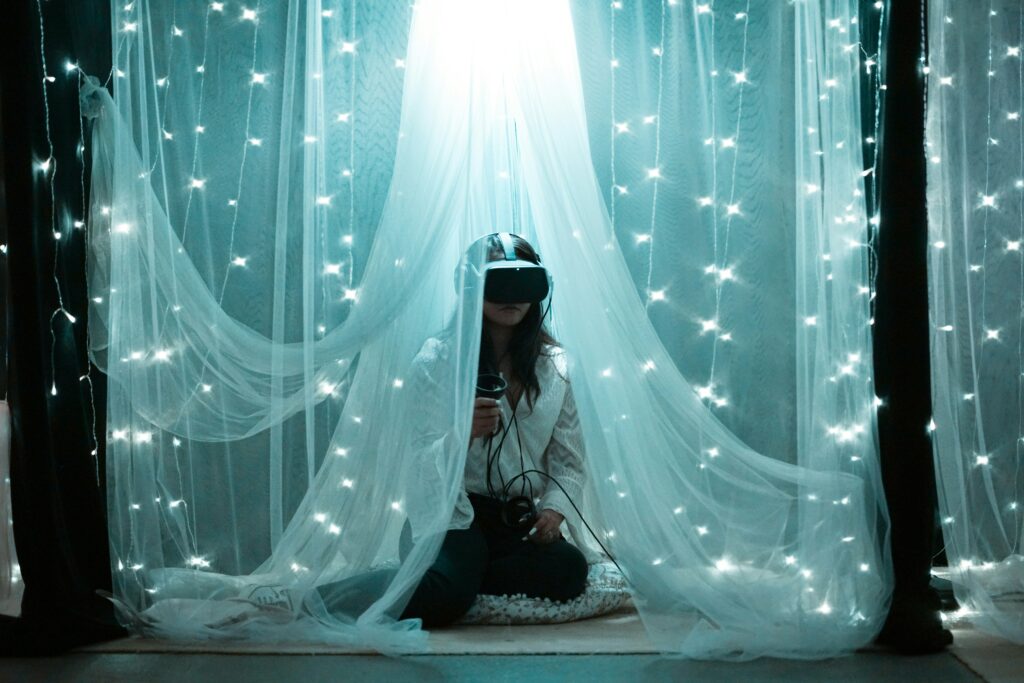Generative AI : Transforming Creative Industries with a Click !!

Generative AI , a subfield of artificial intelligence focused on creating new content, has rapidly emerged as a revolutionary force across various creative industries. From generating artwork and composing music to writing literature and crafting intricate designs, generative AI is redefining the boundaries of creativity and innovation. This long-form article delves into the rise of generative AI, its impact on creative industries, and the profound implications it holds for the future of human creativity.
The Evolution of Generative AI
Generative AI traces its origins to the early experiments with artificial neural networks and machine learning algorithms. However, it was the advent of deep learning and the development of generative adversarial networks (GANs) that truly propelled generative AI into the spotlight. GANs, introduced by Ian Goodfellow and his colleagues in 2014, consist of two neural networks—the generator and the discriminator—that work in tandem to create and evaluate new content. This adversarial process has proven to be highly effective in generating realistic and high-quality outputs.
Since the introduction of GANs, generative AI has undergone significant advancements. Variational autoencoders (VAEs), transformers, and diffusion models have further expanded the capabilities of generative AI, enabling it to produce increasingly sophisticated and diverse content. These advancements have paved the way for generative AI to permeate various creative domains, revolutionizing the way artists, musicians, writers, and designers approach their craft.

Generative AI in Visual Arts
The visual arts have witnessed a remarkable transformation with the integration of generative AI. Artists now have access to powerful tools that can generate original artwork, mimic specific styles, and even collaborate on creative projects. AI-powered platforms like DeepArt and Artbreeder allow artists to experiment with different styles and create unique pieces by blending existing artworks. This fusion of human creativity and machine-generated content has given rise to a new era of digital art.
One notable example is the work of artist Mario Klingemann, who utilizes generative AI to create thought-provoking and visually stunning pieces. Klingemann’s art explores the intersection of human and machine creativity, blurring the lines between the artist and the algorithm. His work highlights the potential of generative AI to push the boundaries of artistic expression and challenge traditional notions of authorship.
Generative AI has also democratized access to art creation. Artists with limited technical skills can leverage AI tools to produce high-quality artwork, leveling the playing field and fostering a more inclusive creative community. This democratization has led to a surge in digital art, with platforms like NFTs (non-fungible tokens) enabling artists to monetize their creations in unprecedented ways.
Generative AI in Movies
The film industry has been profoundly impacted by the rise of generative AI, offering new tools and possibilities for filmmakers, special effects artists, and scriptwriters. Generative AI is being used to create realistic visual effects, streamline the editing process, and even develop entire scenes from scratch. AI algorithms can analyze vast datasets of film footage to generate lifelike CGI characters, landscapes, and environments, reducing the time and cost associated with traditional special effects.
One notable application of generative AI in movies is the de-aging process used in films like “The Irishman.” Traditional de-aging techniques require extensive manual work by visual effects artists. However, AI-driven methods can automate much of this process, creating more realistic results in a fraction of the time. AI can also enhance motion capture technology, providing more accurate and detailed representations of actors’ performances.
Moreover, generative AI is making waves in screenwriting and storytelling. Tools like ScriptBook and AI Dungeon use AI algorithms to analyze story arcs, character development, and dialogue, offering writers valuable feedback and suggestions. This technology can also generate new story ideas and plotlines, aiding writers in the creative process. For example, AI has been used to co-write scripts, providing a fresh perspective and generating content that blends human creativity with machine-generated insights.
AI-driven technologies are also revolutionizing film editing. Adobe’s Sensei, an AI and machine learning platform, powers tools like Adobe Premiere Pro to automate tedious editing tasks, such as scene detection, color correction, and audio balancing. This allows editors to focus on the creative aspects of their work, enhancing the overall quality of the film. The integration of AI in post-production workflows is streamlining processes and enabling filmmakers to bring their visions to life more efficiently.
Generative AI in Video Games
The video game industry has embraced generative AI as a powerful tool for innovation and creativity, fundamentally changing how games are developed, designed, and played. AI-driven technologies are used to create procedurally generated content, develop intelligent NPCs (non-playable characters), and enhance game narratives.
One of the most significant impacts of generative AI in video games is procedural content generation. Games like “No Man’s Sky” and “Minecraft” use AI algorithms to create vast, diverse, and dynamic worlds that players can explore. These algorithms generate terrain, flora, fauna, and even entire ecosystems in real-time, ensuring that no two playthroughs are the same. This not only enhances the replayability of games but also reduces the workload on game developers, who can focus on crafting core gameplay experiences.
Generative AI is also transforming NPC behavior and interactions. Traditional game AI relies on pre-scripted behavior patterns, which can lead to predictable and repetitive interactions. However, generative AI allows NPCs to learn and adapt based on player actions, creating more realistic and engaging experiences. For example, AI-powered NPCs in games like “The Elder Scrolls V: Skyrim” and “Red Dead Redemption 2” can exhibit complex behaviors, making the game world feel more alive and immersive.
In addition to procedural content and NPCs, generative AI is enhancing game narratives and storytelling. AI-driven tools can analyze player choices and adapt the storyline accordingly, creating personalized and dynamic narratives. Games like “Detroit: Become Human” and “Mass Effect” use branching narratives influenced by player decisions, providing a unique experience for each player. AI can also generate dialogue and plotlines, assisting writers in developing richer and more complex stories.
Moreover, generative AI is being used to improve game graphics and animations. Techniques like neural style transfer and deep learning-based upscaling can enhance visual fidelity, making games look more realistic and visually stunning. AI-driven animation tools can create lifelike character movements and facial expressions, adding depth and realism to the gaming experience.
Music Composition and Production
The music industry has been significantly impacted by the rise of generative AI, particularly in composition and production. AI-powered tools like OpenAI’s MuseNet and Google’s Magenta can generate original music compositions in various genres and styles. These tools analyze vast datasets of existing music to create compositions that are both novel and reminiscent of specific musical influences.
One of the most groundbreaking applications of generative AI in music is the creation of AI-generated albums. In 2017, the album “Hello World” by the French collective SKYGGE became one of the first albums entirely composed with the help of AI. The collective used Flow Machines, an AI system developed by Sony CSL, to generate melodies and harmonies, which were then refined and arranged by human musicians. This collaborative approach demonstrated the potential of generative AI to augment human creativity and produce innovative musical works.
Generative AI is also transforming music production by automating repetitive tasks and enhancing the creative process. AI-powered plugins and software can assist with tasks such as sound design, mixing, and mastering, allowing musicians to focus more on the artistic aspects of their work. Additionally, AI can analyze vast amounts of data to identify trends and preferences, helping artists tailor their music to specific audiences and market demands.
Literature and Writing
Generative AI has made significant strides in the realm of literature and writing, offering new possibilities for authors and content creators. Language models like OpenAI’s GPT-3 have demonstrated the ability to generate coherent and contextually relevant text, enabling writers to brainstorm ideas, draft content, and even co-author stories. These models can produce anything from poetry and short stories to full-length novels, opening up new avenues for literary exploration.
One notable example of AI-assisted writing is the novel “1 the Road,” written by Ross Goodwin in collaboration with an AI. Goodwin traveled across the United States with an AI-powered device that generated text based on various inputs, such as GPS data, camera images, and sensor readings. The resulting novel is a unique blend of human and machine creativity, showcasing the potential of generative AI to contribute to the literary arts.
Generative AI is also being used to enhance the editing and revision process. AI-powered tools like Grammarly and ProWritingAid can analyze text for grammar, style, and coherence, providing writers with valuable feedback and suggestions for improvement. These tools not only streamline the writing process but also empower authors to produce higher-quality content.
Design and Architecture
The fields of design and architecture have embraced generative AI as a powerful tool for innovation and creativity. AI-powered design software can generate complex and intricate designs, optimize structures for efficiency, and even create entirely new architectural forms. This has led to a paradigm shift in how designers and architects approach their work, pushing the boundaries of what is possible in these fields.
Generative design tools like Autodesk’s Dreamcatcher and Grasshopper for Rhino allow designers to input specific parameters and constraints, such as material properties and functional requirements, and generate multiple design options. These tools use algorithms to explore a vast design space, identifying optimal solutions that may not have been apparent through traditional methods. This iterative process enables designers to explore a wider range of possibilities and arrive at more innovative and efficient designs.
In architecture, generative AI has been used to create buildings that are both aesthetically pleasing and environmentally sustainable. The work of architect Zaha Hadid exemplifies the potential of AI in architecture. Hadid’s firm, Zaha Hadid Architects, has employed generative design techniques to create futuristic and organic structures that push the boundaries of architectural design. These designs often incorporate complex geometries and fluid forms that are challenging to achieve through conventional methods.
Implications and Ethical Considerations
While the rise of generative AI in creative industries presents numerous opportunities, it also raises important ethical considerations and challenges. One of the primary concerns is the issue of authorship and ownership. When AI generates content, it becomes challenging to determine who holds the intellectual property rights—the human creator, the AI developer, or a combination of both. This ambiguity necessitates the development of new legal frameworks to address the complexities of AI-generated content.
Another ethical consideration is the potential for bias in generative AI systems. AI models are trained on large datasets that may contain inherent biases, which can be reflected in the generated content. For example, language models may produce text that perpetuates stereotypes or reinforces existing biases. It is crucial for developers and users of generative AI to be aware of these biases and take steps to mitigate them, ensuring that AI-generated content is fair and inclusive.
Additionally, the rise of generative AI raises questions about the future of human creativity and the role of artists, musicians, writers, and designers. While AI can augment and enhance human creativity, there is a concern that it may also lead to the devaluation of human contributions. It is essential to strike a balance between leveraging AI’s capabilities and preserving the unique qualities of human creativity that make art and culture rich and diverse.
The Future of Generative AI in Creative Industries
The future of generative AI in creative industries is both promising and uncertain. As AI technology continues to advance, it is likely that generative AI will become increasingly sophisticated and capable of producing even more realistic and innovative content. This evolution will undoubtedly lead to new forms of artistic expression and creative collaboration.
One potential future development is the integration of generative AI with other emerging technologies, such as virtual reality (VR) and augmented reality (AR). This convergence could enable artists and designers to create immersive and interactive experiences that blur the boundaries between the physical and digital worlds. Imagine a virtual gallery where visitors can interact with AI-generated artworks or a concert where AI-generated music adapts in real-time to the audience’s reactions.
Generative AI may also play a significant role in personalized content creation. As AI systems become more adept at understanding individual preferences and tastes, they could generate content tailored to specific audiences. This personalized approach could revolutionize industries such as marketing, entertainment, and education, providing customized experiences that resonate with users on a deeper level.
Furthermore, the collaboration between humans and AI is likely to evolve into more seamless and symbiotic relationships. Rather than viewing AI as a replacement for human creativity, it will be increasingly seen as a tool that enhances and amplifies human potential. This collaborative approach could lead to groundbreaking innovations and artistic achievements that neither humans nor AI could achieve alone.
Case Studies and Success Stories
To illustrate the transformative impact of generative AI in creative industries, let’s explore a few notable case studies and success stories:
Case Study 1: The Next Rembrandt
In 2016, a team of data scientists, engineers, and art historians collaborated on a project called “The Next Rembrandt.” The goal was to create a new painting in the style of the Dutch master Rembrandt van Rijn using generative AI. The team analyzed thousands of Rembrandt’s works, extracting data on his techniques, brushstrokes, and composition. Using this data, they trained a deep learning model to generate a new painting that closely resembled Rembrandt’s style.
The result was a portrait of a man that was strikingly reminiscent of Rembrandt’s work. “The Next Rembrandt” project demonstrated the potential of generative AI to not only mimic the style of a master artist but also to create new art that could be considered a continuation of their legacy. This project received widespread acclaim and highlighted the possibilities of using AI to explore and extend the boundaries of artistic expression.
Case Study 2: Amper Music
Amper Music is a startup that leverages generative AI to create original music compositions. The company’s AI-powered platform allows users to input specific parameters, such as mood, genre, and tempo, and generates custom music tracks in real-time. Amper Music’s technology has been used in various applications, including film scoring, advertising, and video game soundtracks.
One of the notable success stories of Amper Music is its collaboration with Taryn Southern, a singer-songwriter who used the platform to compose her debut album “I AM AI.” Southern provided creative direction and input, while Amper Music’s AI generated the musical arrangements and instrumentation. The album received positive reviews and demonstrated the potential of AI to assist musicians in the creative process.
Case Study 3: Runway ML
Runway ML is a platform that provides artists and creators with access to a wide range of generative AI tools. The platform offers pre-trained models for various creative tasks, including image generation, video editing, and text generation. Runway ML’s user-friendly interface and extensive library of AI models have made it a popular choice among artists, designers, and filmmakers.
One notable project that utilized Runway ML is “Megan,” a short film directed by Jeff Nicholas. The film features AI-generated special effects and visual elements created using Runway ML’s tools. The integration of generative AI allowed the filmmakers to achieve complex visual effects that would have been challenging and time-consuming to create manually. “Megan” received critical acclaim and showcased the potential of generative AI in the film industry.
Conclusion
The rise of generative AI is transforming creative industries in profound ways. From visual arts and music composition to literature, design, movies, and video games, generative AI is redefining the boundaries of creativity and innovation. While the technology presents numerous opportunities, it also raises important ethical considerations and challenges that must be addressed.
As generative AI continues to evolve, it is likely to become an increasingly integral part of the creative process, enabling new forms of artistic expression and collaboration. The future of generative AI in creative industries is bright, promising a world where human creativity and artificial intelligence work hand in hand to produce extraordinary and innovative works of art. By embracing this technology and navigating its complexities, we can unlock the full potential of generative AI and usher in a new era of creativity and innovation.
 Epic Heroes Entertainment Movies Toys TV Video Games News Art Pop culture news goodness
Epic Heroes Entertainment Movies Toys TV Video Games News Art Pop culture news goodness



